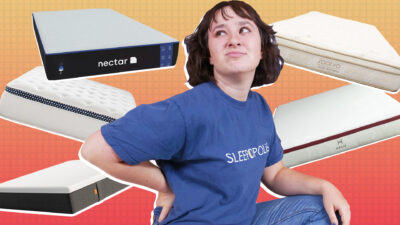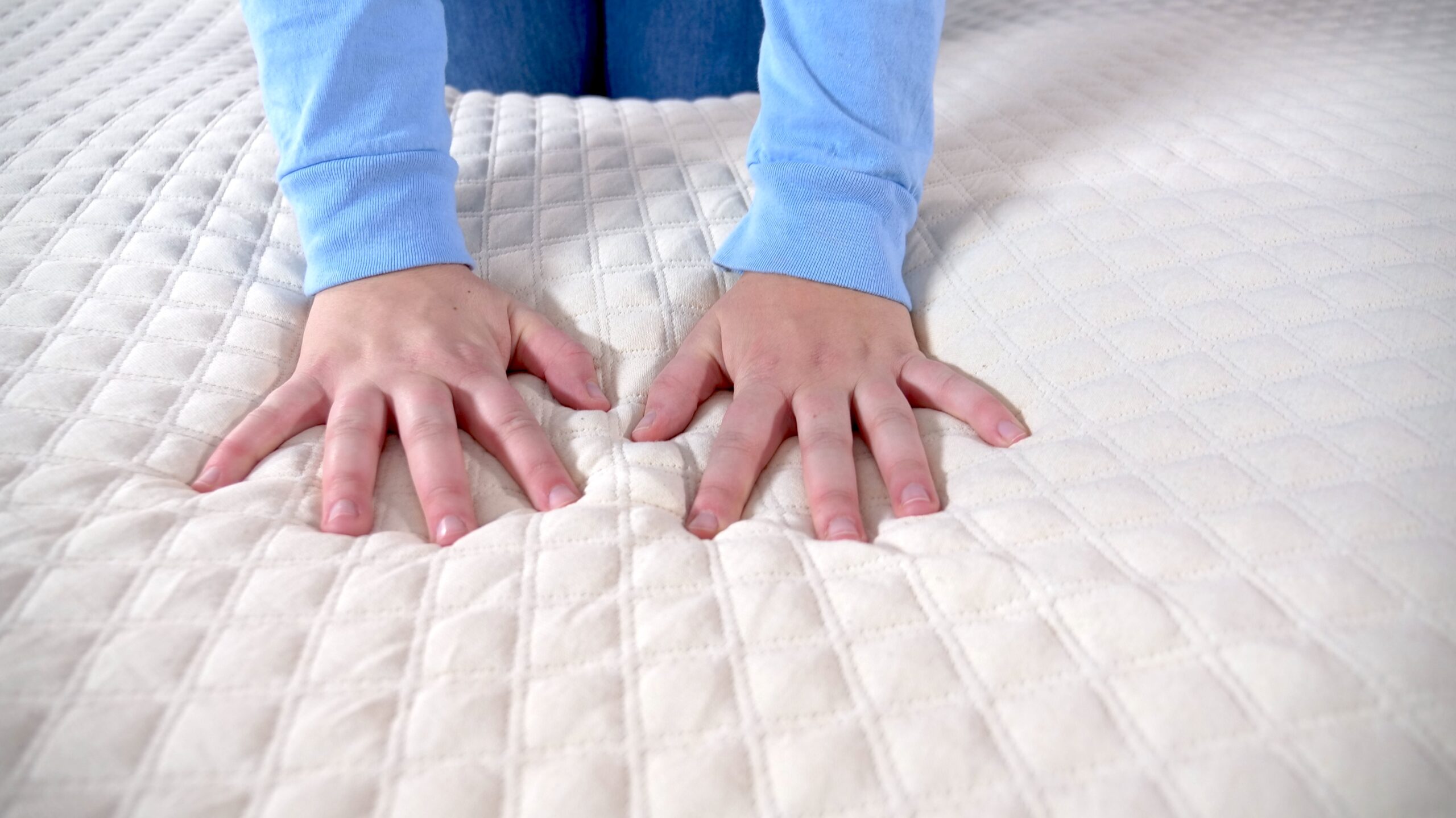
Have you been feeling like you’ve been sinking deeper into your mattress than you’d like, or feel like your bed is too soft and squishy for comfort? Our sleep preferences and bodies can change over time, so your mattress that felt just right when you first bought it may feel a little too broken in for comfort a few years later. Before you consider dragging your mattress to the curb — keep reading. We’ll help you determine whether you need a firmer mattress, and will give you some tips and tricks to upgrade the bed you have to make it more firm and supportive.
Why You Might Need a Firm Mattress
There are several reasons you may need a firmer bed:
Sleeping Position
If you sleep on your back or stomach, you’ll need a firmer mattress to keep your back in a neutral position overnight. If your mattress is too soft and you sleep in one of these positions, your midsection could sink uncomfortably far into the mattress throughout the night which can place extra pressure on your lower back.
Back Pain
Firm mattresses help prop your back up in a healthy posture. Soft beds can allow your joints or other areas of your body to push too far into the bed, which can create pressure and disrupt your natural spinal alignment.
Mattress has Broken in Over Time
After years of use — especially if you sleep with a partner and pets — even the highest quality beds will eventually start to break down. If your bed is sagging and no longer supports you, you may want to look for a new mattress. You could, however, possibly get a few more years out of your bed if you take steps to make your mattress firmer.
A New Sleep Partner
If you like a plush, fluffy bed, but your partner needs a more sturdy sleeping surface to stay comfortable, you’ll need to meet somewhere in the middle. A split king bed could be a good option if it’s in your budget — but if not, you’ll need to adjust your current mattress so you both can stay comfortable.
Why Mattress Firmness Is Important
Mattress firmness plays a huge factor in your quality of sleep — and overall health and well-being. You need a bed that is an appropriate firmness level for your body type, sleeping position, and personal preferences to promote a healthy spinal alignment and prevent potential pains from popping up as you sleep.
The Right Mattress Firmness for You
The right mattress firmness depends greatly on your sleeping position. Here are some of the most popular sleeping positions and the firmness levels that suit them:
- Side sleepers tend to need a softer sleeping surface to cradle the hips and shoulders as they sink into the bed. Firmer beds can create pressure in these areas and cause aches and pains.
- Back sleepers usually prefer a bed that is a medium-firm firmness level — fairly firm, but still soft enough so it has gentle give that can conform to the natural shape of your body. This helps keep the body supported without putting pressure on your curves.
- Stomach sleepers usually need a firm mattress. In softer beds, your hips can sink deeply into the mattress, which can put your spine out of alignment and cause back pain.
- Combination sleepers typically sleep best on a medium-firm bed. This middle-of-the-road firmness level suits most sleepers and body types, and isn’t so soft that you feel stuck in a doughy bed as you try to change sleeping positions.
The wrong bed firmness level will lower the quality of your sleep — which could cause you to wake up groggy and sore, impacting your health, performance, and quality of life.
Mattress Thickness
It is also important to consider mattress thickness. A thicker mattress is made of taller layers, which can help prevent sinkage. This extra support is especially helpful for stomach sleepers or those with heavyweight body types. See our mattress thickness guide to find a bed with an ideal thickness for your sleep needs.
How to Make Your Mattress Firmer
If a new mattress isn’t in your budget, try these tips to fix up the bed you have.
Check Your Trial Period
Most mattresses come with a sleep trial period that is typically between 30 and 365 days. If you are within your sleep trial period and your bed is still in a good condition, you may be able to swap out your bed for a firmer model at no or a low cost.
Look at Your Warranty
If your mattress is still under warranty, your overly-soft bed may be eligible for a repair or replacement. Some mattress companies will cover the damage if layers are worn out or your body indentations are very deep.
Rotate or Flip Your Mattress
If you sleep in the same place on your bed and sleeping position every night, your bed may start to get soft and saggy in that area. You can rotate your bed every few months to help limit the amount of wear on your bed to keep it feeling firm and supportive. You can also flip some mattresses — but make sure to check with your mattress manufacturer to make sure this will help.
Inspect Your Box Spring or Frame
If you have the wrong type of bed foundation or are resting your mattress on an old, broken, or worn-out foundation — your mattress may be sagging and feel softer than it actually is. Tighten and fix up your bed frame if it’s looking sub par. If you can’t fix it, you may need to just replace your bed frame to get the support you need.
Add Plywood
Adding a plywood board beneath your mattress is a cheap and easy fix to help add some firmness to your bed. This mattress firmness hack adds support to your foundation and adds another layer of firm support to your mattress.
Get a Mattress Topper
Adding a mattress topper to your bed is like adding an extra layer of support, and there are mattress toppers available that are designed to make your bed firmer. As an added perk, these toppers can also add durability and cooling features to your mattress.
Move Your Mattress to the Floor
If your mattress feels too soft on a foundation and you’ve exhausted all other options, you can consider placing it directly on the floor to sleep on. Make sure your floor is clean to avoid exposure to allergens and dirt. Also — keep in mind that putting your mattress on the floor can void some warranties that require your bed to be used with specific foundations.
Make Bedding Flat and Tight
Extra bedding can make your mattress feel softer. Use thin bedding and tuck it tightly into your mattress to avoid creating extra fluff if you want a firmer feel.
Watch the Thermostat
Some mattresses, like memory foam, can be affected by temperature. Changes in temperature make the mattress materials expand and contract, which can compromise the level of support and make the bed feel less firm. If your bedroom is warmer, then your bed will feel softer. We recommend you keep your bedroom between 60 and 72 degrees.
Keep Your Mattress Dry
Humid weather conditions and sweaty nights can make your mattress damp over time. Damp mattresses tend to get softer and squishier. If your mattress is feeling a little soggy, try drying it out outside in the sun and keeping it wrapped in a moisture-wicking mattress cover and sheets.
How To Know When To Replace Your Mattress
When your mattress is too soft, you’ve had it for a while, and nothing you try will make it more comfortable, it might be time to replace your mattress. Even the most high-quality mattresses will break down over time. You may want to start shopping for a new mattress if your bed has visible signs of wear and tear, like lumps or sagging, or you’ve been sleeping on it for more than five years and noticed you’ve started waking up feeling sore. If you decide to go this route, don’t forget to shop sales and recycle your current mattress if you can.
The Best Firm Mattresses
If you’ve tried to add some extra support to your mattress with not much luck, you should replace your old bed with one of the top-reviewed firm mattresses.
Plank Firm: We recommend the Plank Firm mattress as a great overall pick. This flippable bed provides firm and ultra-firm options in a single bed for a price around a thousand dollars.
The Plank mattress is an all-foam, flippable mattress with a firm side and an extra-firm side, which makes it great for both back sleepers and stomach sleepers. Both sides of the mattress should provide stomach sleepers with the right amount of support needed, while back sleepers will be happiest on the firm side.
We recommend this mattress for the following sleeper types: Financing options are available for this mattress. This is my 4th foam mattress. Lasting firmness is one of the challenges I have come across with the mattresses. This is the most firm I have purchased and after a few weeks, I am still happy.
The Plank mattress is an all-foam, flippable mattress with a firm side and an extra-firm side, which makes it great for both back sleepers and stomach sleepers. Both sides of the mattress should provide stomach sleepers with the right amount of support needed, while back sleepers will be happiest on the firm side.
We recommend this mattress for the following sleeper types: Financing options are available for this mattress. This is my 4th foam mattress. Lasting firmness is one of the challenges I have come across with the mattresses. This is the most firm I have purchased and after a few weeks, I am still happy.
The Plank mattress is an all-foam, flippable mattress with a firm side and an extra-firm side, which makes it great for both back sleepers and stomach sleepers. Both sides of the mattress should provide stomach sleepers with the right amount of support needed, while back sleepers will be happiest on the firm side.
We recommend this mattress for the following sleeper types: Financing options are available for this mattress. This is my 4th foam mattress. Lasting firmness is one of the challenges I have come across with the mattresses. This is the most firm I have purchased and after a few weeks, I am still happy.
Brooklyn Bedding Plank Firm Mattress
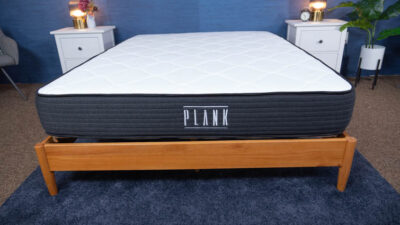
Material
Foam
Trial Period
120 nights
Shipping Method
Free shipping
Firmness
Multiple firmness options
Warranty
10-year warranty
Price Range
$$$$$
Back Pain
This bed is perfect for anyone suffering from back pain.
Stomach Sleeping
Ideal for average weight and heavyweight stomach sleepers.
Financing Options
Brooklyn Bedding Plank Firm Mattress

Material
Foam
Warranty
10-year warranty
Firmness
Multiple firmness options
Shipping Method
Free shipping
Trial Period
120 nights
Price Range
$$$$$
Back Pain
This bed is perfect for anyone suffering from back pain.
Stomach Sleeping
Ideal for average weight and heavyweight stomach sleepers.
Financing Options

Brooklyn Bedding Plank Firm Mattress
Material
Foam
Firmness
Multiple firmness options
Trial Period
120 nights
Warranty
10-year warranty
Shipping Method
Free shipping
Price Range
$$$$$
Back Pain
This bed is perfect for anyone suffering from back pain.
Stomach Sleeping
Ideal for average weight and heavyweight stomach sleepers.
Financing Options
Nectar Premier Copper: If you sleep with a partner, or are a back or side sleeper who prefers a firmer feel, you could also check out the Nectar Premier Copper bed. This medium-firm bed balances support and comfort and provides a cool sleeping experience for a memory foam bed.
The cooling technology in this mattress sets it apart. A lot of memory foam mattresses trap body heat and sleep hot, while the Nectar Premier Copper works to fix this issue, and sleeps cooler than any other mattress in the Nectar Sleep all-foam line.
We recommend this mattress for the following sleeper types: Financing options are available for this mattress. The cooling technology in this mattress sets it apart. A lot of memory foam mattresses trap body heat and sleep hot, while the Nectar Premier Copper works to fix this issue, and sleeps cooler than any other mattress in the Nectar Sleep all-foam line.
We recommend this mattress for the following sleeper types: Financing options are available for this mattress. The cooling technology in this mattress sets it apart. A lot of memory foam mattresses trap body heat and sleep hot, while the Nectar Premier Copper works to fix this issue, and sleeps cooler than any other mattress in the Nectar Sleep all-foam line.
We recommend this mattress for the following sleeper types: Financing options are available for this mattress.Nectar Premier Copper Mattress
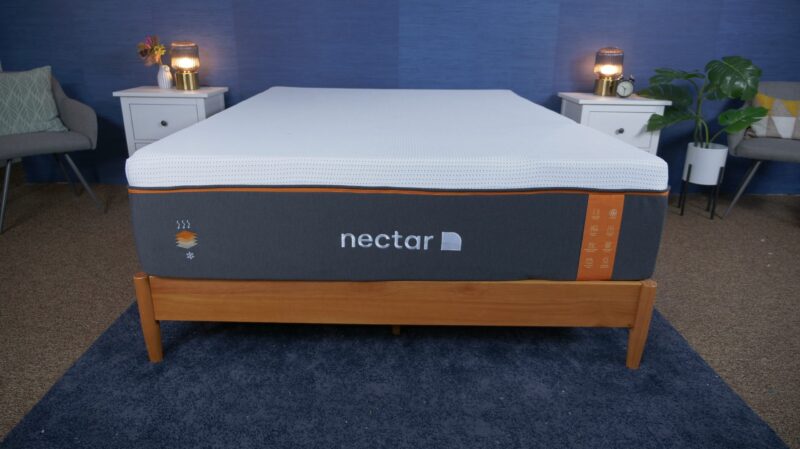
Material
Foam
Trial Period
365 nights
Shipping Method
Free shipping
Firmness
Firm: 7/10
Warranty
Lifetime warranty
Price Range
$$$$$
Hot Sleepers
If you often overheat while you sleep, this mattress should help you stay cool.
Back Sleeping
Ideal for lightweight and average weight back sleepers.
Side Sleeping
Ideal for lightweight and average weight side sleepers.
Financing Options
Nectar Premier Copper Mattress

Material
Foam
Warranty
Lifetime warranty
Firmness
Firm: 7/10
Shipping Method
Free shipping
Trial Period
365 nights
Price Range
$$$$$
Hot Sleepers
If you often overheat while you sleep, this mattress should help you stay cool.
Back Sleeping
Ideal for lightweight and average weight back sleepers.
Side Sleeping
Ideal for lightweight and average weight side sleepers.
Financing Options

Nectar Premier Copper Mattress
Material
Foam
Firmness
Firm: 7/10
Trial Period
365 nights
Warranty
Lifetime warranty
Shipping Method
Free shipping
Price Range
$$$$$
Hot Sleepers
If you often overheat while you sleep, this mattress should help you stay cool.
Back Sleeping
Ideal for lightweight and average weight back sleepers.
Side Sleeping
Ideal for lightweight and average weight side sleepers.
Financing Options
Saatva Classic: Another great option is the Saatva mattress. This luxury innerspring bed is built with layers of bouncy innerspring coils that make the bed responsive and breathable, but also incorporates memory foam comfort layers for contouring comfort. It comes in three different firmness levels, so you can choose the best version for you.
The Saatva’s coil-on-coil construction provides a classic innerspring feel. It's a good option for combo sleepers, who will want to feel free to switch positions and avoid feeling “stuck” in the mattress. It comes in three firmness levels, so you should be able to find one that suits your needs.
We recommend this mattress for the following sleeper types: Financing options are available for this mattress. We were skeptical of buying a mattress on line but it could not have gone any smoother. Anthony answered all of our questions during our many phone conversations. Delivery was prompt and went without a hitch. Best of all the mattress is so comfortable! I haven't had such a good night sleep in years. Highly recommend this.
The Saatva’s coil-on-coil construction provides a classic innerspring feel. It's a good option for combo sleepers, who will want to feel free to switch positions and avoid feeling “stuck” in the mattress. It comes in three firmness levels, so you should be able to find one that suits your needs.
We recommend this mattress for the following sleeper types: Financing options are available for this mattress. We were skeptical of buying a mattress on line but it could not have gone any smoother. Anthony answered all of our questions during our many phone conversations. Delivery was prompt and went without a hitch. Best of all the mattress is so comfortable! I haven't had such a good night sleep in years. Highly recommend this.
The Saatva’s coil-on-coil construction provides a classic innerspring feel. It's a good option for combo sleepers, who will want to feel free to switch positions and avoid feeling “stuck” in the mattress. It comes in three firmness levels, so you should be able to find one that suits your needs.
We recommend this mattress for the following sleeper types: Financing options are available for this mattress. We were skeptical of buying a mattress on line but it could not have gone any smoother. Anthony answered all of our questions during our many phone conversations. Delivery was prompt and went without a hitch. Best of all the mattress is so comfortable! I haven't had such a good night sleep in years. Highly recommend this.
Saatva Mattress
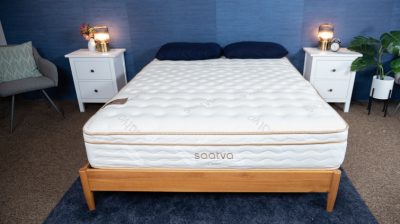
Material
Innerspring
Trial Period
365 nights
Shipping Method
Free white glove delivery
Firmness
Multiple firmness options
Warranty
Lifetime warranty
Price Range
$$$$$
Hot Sleepers
If you often overheat while you sleep, this mattress should help you stay cool.
Back Pain
This bed is perfect for anyone suffering from back pain.
Back Sleeping
Ideal for lightweight, average weight, and heavyweight back sleepers.
Stomach Sleeping
Ideal for lightweight and average weight stomach sleepers.
Financing Options
Saatva Mattress

Material
Innerspring
Warranty
Lifetime warranty
Firmness
Multiple firmness options
Shipping Method
Free white glove delivery
Trial Period
365 nights
Price Range
$$$$$
Hot Sleepers
If you often overheat while you sleep, this mattress should help you stay cool.
Back Pain
This bed is perfect for anyone suffering from back pain.
Back Sleeping
Ideal for lightweight, average weight, and heavyweight back sleepers.
Stomach Sleeping
Ideal for lightweight and average weight stomach sleepers.
Financing Options

Saatva Mattress
Material
Innerspring
Firmness
Multiple firmness options
Trial Period
365 nights
Warranty
Lifetime warranty
Shipping Method
Free white glove delivery
Price Range
$$$$$
Hot Sleepers
If you often overheat while you sleep, this mattress should help you stay cool.
Back Pain
This bed is perfect for anyone suffering from back pain.
Back Sleeping
Ideal for lightweight, average weight, and heavyweight back sleepers.
Stomach Sleeping
Ideal for lightweight and average weight stomach sleepers.
Financing Options
FAQs
What are the benefits of a firm mattress?
There are health benefits to a firm mattress. Firm beds can help keep your back propped up in a healthy posture to prevent aches and pains from popping up in the morning.
Can a mattress topper make a bed firmer?
If you choose the right mattress topper, it could help make your bed firmer. A mattress topper can add another layer of support to push back against your body to create a firmer feel for your mattress.
Is a firm mattress better for your back?
Depending on your sleeping position and body type, a firmer mattress could be better for your back. If you sleep on your back or stomach, or have a heavier body type, a firmer bed could help prevent sinkage and support a healthy posture.
Who needs a firmer mattress?
Those with heavier body types, stomach sleepers, and some back sleepers typically need a firmer mattress to keep the spine in a healthy alignment on top of the bed throughout the night. Side sleepers and those with lightweight bodies typically need a softer bed to provide pressure relief.
Is a mattress pad the same as a mattress topper?
A mattress pad and mattress topper both lay on the top of the mattress, but they have different feels and purposes. Mattress pads typically help protect against allergens and provide a subtle change to the feel of your bed. Mattress toppers add another thick layer of comfort or support to your bed and can change the firmness level and feel of your bed. See our guide to mattress pads and toppers for more details.
Conclusion
Many sleepers, including back sleepers, stomach sleepers, and back pain sufferers, can benefit greatly from a firmer mattress. If your mattress has been feeling too soft for comfort and you wake up sore in the mornings, there are several low-cost tips and tricks you can try to make your mattress firmer. If you try to make your mattress firmer without success, you may want to consider shopping for a new mattress that meets your needs so you don’t compromise the quality of your sleep and health.


